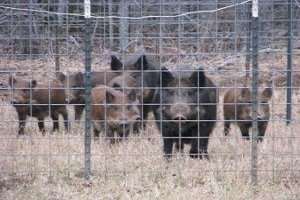By Dr. Billy Higginbotham
Wild pigs are most vulnerable to trapping before food and forages become more available in the spring, said a Texas A&M AgriLife Extension Service expert.
Dr. Billy Higginbotham, AgriLife Extension wildlife specialist, Overton, said most acorns have either been consumed or are rotting on the ground now, and wild pigs are searching for alternative food sources.

“This time period before spring greenup is prime for trapping wild pigs using best management practices,” Higginbotham said. “Wild pigs are searching hard for food during this period, which makes them more vulnerable to trapping.”
Higginbotham said it might take up to a month for the entire trapping process, which allows time for the pigs to be properly trained to take bait and get used to the presence of a trap. Other control activities, such as shooting and hunting with dogs, should be stopped during the trapping effort.
Start by baiting an area as close to the pigs’ daytime cover rather than the specific area damaged, Higginbotham said. Landowners should determine how many wild pigs are in the sounder causing damage by establishing multiple bait sites and using game cameras to determine the number of pigs responding to bait.
“Many baits are available, but shelled corn is often used as long as the landowner does not mind some non-target use by species such as raccoons, squirrels and deer,” he said.
Higginbotham said he recommends the use of corral traps with a tire trigger on the ground.
“Tires work better than tripwires because it takes larger pigs to tip the tire enough to trip it,” he said. “And because larger pigs are always the last to enter a trap, you will have a better chance of catching the entire sounder.”
The tire that will be used as a trigger mechanism should be placed in the bait area when baiting begins, he said. Place corn in the tire to encourage the pigs to move it enough to shake the corn out.
But the trap should not be built until the pigs are routinely attracted to the baited area, he said.
The sounder size will determine the trap size, but no corral trap should be smaller than 4 by 16 foot panels with four by 4-inch mesh, Higginbotham said.
“The fate of the pigs will determine trap shape,” he said. “A teardrop shape is recommended if the pigs are to be sold to a buying station, as this style facilitates load-out from the trap. Other trap configurations can be used if the pigs are to be euthanized on site.”
Square or rectangular traps should have corners covered with a piece of panel or mesh fencing to prevent pigs from climbing out of the trap, he said.
“When you arrive at the trap, the pigs will naturally go to the farthest corner and start piling up trying to get away,” he said. “If the corners aren’t covered, they can escape by climbing on top of each other.”
When game camera monitoring shows the pigs are on the bait build the trap around the area using the panels supported by T-posts every 4-5 feet with zip ties, Higginbotham said. Tie wire should be used to secure the panels flush to the ground and to the t-posts at the top, middle and bottom of each t-post.
Keep an opening where the gate will be pulled back to create a funnel at least 10 feet wide to encourage the pigs to enter the trap. Wider openings decrease the time needed to train the pigs that they can safely enter and feed in the back of the trap.
“Continue to bait trap the area and offer an increased amount of bait in the rear of the trap and a decreasing amount immediately outside and just inside of the trap,” Higginbotham said.

Click here to see more...